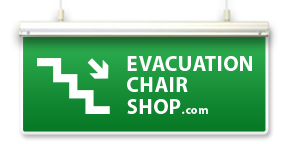Evacuation Chairs and Risk Assessments1 April 2016 In our earlier post about People Who May Need Evacuation Chairs, we talked about how there is no one person or one situation for which an evacuation chair is made for. Similarly, there is no set guideline to indicate how many evacuation chairs your work space should have: it all depends on individual circumstances and factors specific to your environment. Therefore, the importance of conducting a risk assessment within your company cannot be stressed enough. Read on to find out more about what risk assessments are, why you need to have them and how they relate to evacuation chairs. What is a Risk Assessment? The HSE (Health and Safety Executive) states that “a risk assessment is simply a careful examination of what, in your work, could cause harm to people.” Once you have completed a study of your space, you need to “weigh up whether you have taken enough precautions or should do more to prevent harm” and act accordingly. Conducting a risk assessment therefore doesn't need to become an over-complicated process weighed down with paperwork and stress. It relies simply on being aware of your surroundings, taking everybody in the workforce into account and using common sense. If you’re doing these things then you’re already halfway there. What Does the Law Say? The safety and well-being of your staff should be enough to motivate any employer to assess risks and protect them as far as possible, but it’s also the law. Under the Management of Health and Safety at Work Regulations Act 1999, it is stated that a “suitable and sufficient” risk assessment must be carried out by an employer. The Fire Regulatory Reform Act 2005 also states it is the responsibility of business owners to ensure an evacuation plan is in place for everyone in the building, which brings us to evacuation chairs. How Many Evacuation Chairs Do I Need? Potential buyers of evacuation chairs often ask how many they need for their environment. This is where a risk assessment comes in. While there is no concrete answer to this question, a general rule of thumb is that you should have as many chairs as you have potential users per floor. Using this as a guide to work from, you can then assess and take into account additional factors which could affect the number of chairs required and their locations. There may, for instance, be a woman working on the third floor of your office building who has recently reached full-term pregnancy, meaning she may now find it more difficult to quickly descend stairs, thus requiring one chair to be installed on the third floor. If another two employees with mobility issues work on varying floors, then another two chairs would have to be installed on each respective floor. Perhaps you’re a store manager and you’ve noticed a group of disabled customers who regularly use the cafeteria on the top floor, in which case several evacuation chairs will need to be available for their use. It is factors like these which will play into your risk assessment and influence employers’ decisions with regard to evacuation chairs. When Evacuation Chairs are Not the Answer A risk assessment is not just useful for determining how many chairs you may need and where to place them, but also whether an evacuation chair is the right choice in the first place. SledgesIf a person is completely unable to support their weight, it might be difficult to get them into an evacuation chair. In these cases, often an evacuation sledge is a more suitable alternative. This allows a person to be transferred horizontally and taken down stairs whilst they are lying down. This is ideal for those who are less mobile - you may, for example, consider an evacuation sledge if an employee suffers from epilepsy and is prone to seizures. You should also consider a sledge if your building has curved or spiral staircases as evacuation chairs are usually only suitable for use on straight, winder and landing staircases. Sheets and MattressesEvacuation sheets and mattresses are for use with bedridden people in situations where moving them could be dangerous. Designed for maximum comfort, using an evacuation sheet or mattress means the user does not have to leave their bed. This is perfect for use in care homes and hospitals, which often have multiple storeys and many bedridden patients who would struggle to escape in an emergency. GEEP-ing on Top of ThingsHaving a PEEP and GEEP – A Personal and General Emergency Evacuation Plan – is important in any situation, but especially for employers who are responsible for a number of people as well as themselves. Just as there’s little point spending money on an evacuation chair if you don’t know how to use it, there’s no point owning the chair if you haven’t worked it into your emergency evacuation plan. Using a risk assessment to determine how many chairs you need, where to place them and whether you need an alternative evacuation method like a sledge or mattress, will help you get the most out of your product in the unlikely event that you need to use it. |
|
£0.00  Need Some Advice? 020 7501 1103  |
